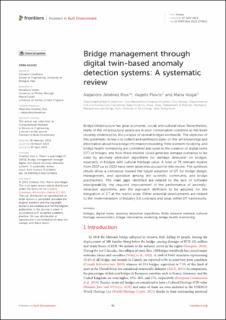| dc.contributor.author | Jiménez Rios, Alejandro | |
| dc.contributor.author | Plevris, Vagelis | |
| dc.contributor.author | Nogal, Maria | |
| dc.date.accessioned | 2023-10-20T06:22:01Z | |
| dc.date.available | 2023-10-20T06:22:01Z | |
| dc.date.created | 2023-04-08T12:13:26Z | |
| dc.date.issued | 2023 | |
| dc.identifier.citation | Frontiers in Built Environment. 2023, 9 . | en_US |
| dc.identifier.issn | 2297-3362 | |
| dc.identifier.uri | https://hdl.handle.net/11250/3097688 | |
| dc.description.abstract | Bridge infrastructure has great economic, social, and cultural value. Nevertheless, many of the infrastructural assets are in poor conservation condition as has been recently evidenced by the collapse of several bridges worldwide. The objective of this systematic review is to collect and synthesize state-of-the-art knowledge and information about how bridge information modeling, finite element modeling, and bridge health monitoring are combined and used in the creation of digital twins (DT) of bridges, and how these models could generate damage scenarios to be used by anomaly detection algorithms for damage detection on bridges, especially in bridges with cultural heritage value. A total of 76 relevant studies from 2017 up to 2022 have been taken into account in this review. The synthesis results show a consensus toward the future adoption of DT for bridge design, management, and operation among the scientific community and bridge practitioners. The main gaps identified are related to the lack of software interoperability, the required improvement of the performance of anomaly- detection algorithms, and the approach definition to be adopted for the integration of DT at the macro scale. Other potential developments are related to the implementation of Industry 5.0 concepts and ideas within DT frameworks. | en_US |
| dc.language.iso | eng | en_US |
| dc.rights | Navngivelse 4.0 Internasjonal | * |
| dc.rights.uri | http://creativecommons.org/licenses/by/4.0/deed.no | * |
| dc.title | Bridge management through digital twin-based anomaly detection systems: A systematic review | en_US |
| dc.type | Peer reviewed | en_US |
| dc.type | Journal article | en_US |
| dc.description.version | publishedVersion | en_US |
| cristin.ispublished | true | |
| cristin.fulltext | original | |
| cristin.qualitycode | 1 | |
| dc.identifier.doi | 10.3389/fbuil.2023.1176621 | |
| dc.identifier.cristin | 2139720 | |
| dc.source.journal | Frontiers in Built Environment | en_US |
| dc.source.volume | 9 | en_US |
| dc.source.pagenumber | 18 | en_US |

